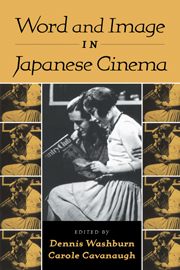Book contents
Introduction
Published online by Cambridge University Press: 01 March 2010
Summary
I was probably five or six when I saw a moving picture for the first time. I went with my father, if I remember rightly, to see this marvelous novelty at the Nishuro in Okawabata. The motion pictures were not projected on a large screen as they are nowadays. The size of the image was a rather small four-by-six feet or so. Also, they had no real story, nor were they as complex as films are these days. I remember, among the pictures that evening, one of a man fishing. He hooked a big one and then fell head over heels back into the water. He wore some kind of straw hat, and behind the long fishing pole he held in his hand were reeds and willows waving in the wind. Oddly enough, though my memory may be wrong, I fancy the man looked something like Admiral Nelson.
Akutagawa Ryûnosuke, Tsuioku, (Memoirs, 1926)In February 1897 both the Lumière brothers' Cinématographe and Edison's Vitascope arrived in Japan along with programs of short films. These moving pictures, generally no more than one minute long, were shown at venues like the Nishuro, halls for scientific displays, public meetings, and art exhibitions. Films were thus initially presented in Japan as a commercial spectacle, an educational experience, and a demonstration of the unprecedented capacity of technology to reproduce the real.
The near-simultaneity in the introductions of the cinema to Europe, the United States, and Japan was to have a marked effect on the generation that came of age in the 1910s and 1920s.
- Type
- Chapter
- Information
- Word and Image in Japanese Cinema , pp. xix - xxviiiPublisher: Cambridge University PressPrint publication year: 2000



